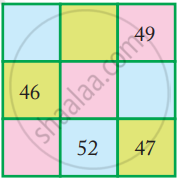Advertisements
Advertisements
प्रश्न
If A × 3 = 1A, then A = ______.
उत्तर
If A × 3 = 1A, then A = 5.
Explanation:
We have, A
× 3
1A
Here, 3 × A is a two-digit number whose unit digit is A.
A can take any value between 0 to 9, but only A = 5 satisfies the product.
Hence, A = 5
APPEARS IN
संबंधित प्रश्न
Without performing actual addition and division write the quotient when the sum of 69 and 96 is divided by
(i) 11
(ii) 15
Given an example of a number which is divisible by 4 but not by 8.
Which of the following statement is true?
The sum of two consecutive odd numbers is always divisible by 4.
Do you remember magic triangles? Come now, let s make some magic squares.
- Fill this square using all the numbers from 46 to 54.
Rule: The total of each line is 150.
The difference of a two-digit number and the number obtained by reversing its digits is always divisible by ______.
The difference of three-digit number and the number obtained by putting the digits in reverse order is always divisible by 9 and ______.
If  then B = ______.
then B = ______.
If B × B = AB, then either A = 2, B = 5 or A = ______, B = ______.
A four-digit number abcd is divisible by 4 if ab is divisible by 4.
Fill in the blank space in the same way.

